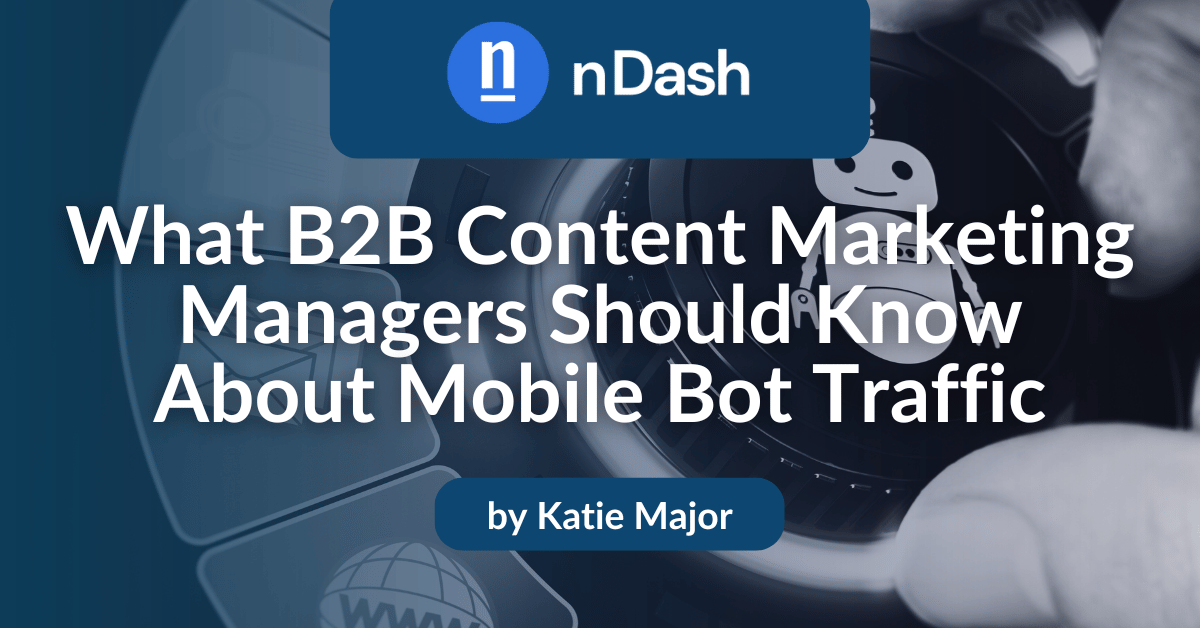Today, we’re unpacking the impact of bot and click farms on lead quality with advertising experts and content marketing managers.
But first, have you ever heard of the “dead internet theory?” It’s the belief that today’s internet primarily consists of bots and AI. Users, posts, and traffic – all fake. Seriously, it’s a thing.
Yet, this is conspiracy lore – not true. What is true is the troubling rise of bot farms. That really is the dead internet. Fake views, likes, traffic, and posts.
As content marketing managers, we know that mobile marketing is critical for B2B success. But are your mobile leads real? Bot farms are not just the occasional fake. They can actually distort key performance metrics, among other things.
Here’s what you need to know:
The Rise of Mobile Bot Farms: What B2B Content Marketing Managers Need to Know
Click fraud occurs when a human or bot intentionally clicks on an ad or webpage to manipulate engagement. The goal is to inflate click metrics to waste ad spend. It has a huge ripple effect on brand advertising – if money is wasted, there’s less to spend later.
Service providers, SaaS, e-comm brands, financial institutions, content creators, and healthcare organizations are all at risk for fraudulent click activity. These sectors typically invest in high-ticket campaigns that prioritize traffic and form submissions. As a result, they become attractive targets for automated activity that mimics real engagement.
They’re also organized and sophisticated. Without CAPTCHA verification, bots can submit forms, and “bad actors” can behave in a way that feels real. Bad actors can also provide email addresses and generally “act” interested.
How Widespread Is Mobile Bot Activity?
The facts are very sobering. According to Imperva’s 2024 Bad Bot Report, nearly 50% of internet traffic originates from non-human sources. On top of that, malicious bots account for almost one-third of all traffic. We’re at a tipping point now where bot activity will likely surpass human activity.
Content marketing managers must think beyond pageviews and impressions to stay ahead of increasingly smart bot and click farm activity.
“B2B content marketing managers should indeed rethink mobile metrics given the growing impact of bot farms on data integrity,” says Shehar Yar, CEO of Software House. “It’s essential to recognize that not all traffic is genuine, and inflated mobile performance numbers could lead to misguided strategies.”
How Mobile Bot Farms Distort Lead Quality and Conversion Data
Despite appearing as real engagement, bot-driven traffic often creates misleading performance metrics that fail to convert down the funnel. High click-through rates, form submissions, and session duration are all KPIs that bot data can warp.
James Owen, Co-Founder of Click Intelligence, warns that “fake leads are a major issue because bots constantly fill out forms.” Such bot behavior complicates the process of distinguishing authentic leads. He recommends verifying email addresses via CAPTCHA and tracking behavior to ensure actions match real users.
The harsh reality is that bot traffic doesn’t just hurt ads – sales and strategy also take a hit. “You cannot build strategies on a broken foundation,” says Sergey Ermakovich, CMO of HasData. “Assess lead authority by analyzing behavioral patterns. Focus on certain signals such as time spent on the page, scroll depth, or the sequence of page visits.”
The Ripple Effect
Sergey makes a huge point here. If a brand sees its paid campaigns as successful, why wouldn’t it try to build on that? It’s not just one campaign that can be affected; it can mean the whole strategy is compromised.
Building ad campaigns on false data has unfortunate consequences. They could be spending their budget on tactics that will actually work.
How Content Marketing Managers Can Spot and Mitigate Bot Traffic
With fake internet traffic on the rise, it’s time to look beyond the metrics susceptible to bot and bad actor activity. While CTRs, form submissions, and time on page are important, we know these metrics are easily played with.
B2B marketers must proactively detect and filter out faux traffic to ensure data accuracy and better decision-making. Gone are the days when relying on surface-level analytics is enough. It’s time to get our hands dirty. Here’s how to do it:
Track Behavioral Data
Tracking behavioral data is one of the most effective (and practical) ways to separate bots from legitimate users. Shane McEvoy, MD of Flycast Media, suggests, “One effective strategy is filtering analytics by device type and location to spot unusual patterns. For example, if mobile engagement drops significantly while traffic surges, it may indicate bot activity.”
Leverage AI Tools to Isolate Bot Activity
AI can assist in identifying and mitigating bot activity. Ryan T. Murphy, Sales Operations Manager at Upfront Operations, says: “Content marketing managers should leverage AI-powered analytics tools that can distinguish human behavior from bot activity by analyzing time-on-page and bounce rates.”
He also recommends regularly auditing mobile performance data to monitor suspicious activity. For example, sudden high activity from abnormal geolocations can mean a high likelihood of bot or click farm activity.
Pair Manual and Automated Attribution Models
Bot filtering shouldn’t stop at analytics. “Tools like CAPTCHA and services like DataDome can block automated submissions,” says James Owen, Co-Founder of Click Intelligence. He adds, “AI-driven fraud detection, combined with manual review, can help prevent bots from inflating numbers.”
To ensure only legitimate leads enter your funnel, Kay Velik of Nine Peaks Media advises: “I verify email domains, check LinkedIn profiles, and assess behavioral consistency. Attribution models must evolve to filter out bot-driven actions.” She adds, “Instead of trusting surface-level analytics, I focus on engagement signals like session duration, scroll depth, and interaction patterns.”
Signs of Bot Traffic Every Content Marketing Manager Should Watch
- Unusual spikes in mobile engagement that don’t translate to conversions.
- Spikes of engagement from locales that don’t align with your usual traffic.
- High bounce rates and low time-on-site despite increased traffic.
- Identical or repetitive form fills, email signups, and click patterns.
Future-Proofing B2B Marketing Metrics Against Bot Activity
While manual data-diving may work for some, it won’t work for most. As bot technology advances, B2B marketers must evolve their strategies to ensure lead quality and marketing efficiency.
Using machine learning to support lead scoring frees up time, improves accuracy, and ensures your sales team has good prospects. “We, at DIGITECH, used machine learning to enhance our lead scoring model,” says Darryl Stevens, CEO of Digitech Web Design. “This strategy not only improved capitalizing the quality of our leads, but provided our sales teams with crystal clear targets to shoot for, and ultimately increased conversion rates.”
Understanding which traffic sources are most likely to bring in bots is key for optimizing marketing attribution models. Clayton Johnson TCM, owner of Twin City Marketing, shares: “In combating bots, dissecting traffic sources can reveal genuine user patterns. These patterns help optimize attribution models by focusing on content-driven user engagements that typify authentic interactions.”
Stephen Dominic Giuttari of Market Boxx echoes this: “We actively monitor traffic patterns for anomalies indicative of bot activity… This kind of data helps us fine-tune our attribution models to better reflect the actions of authentic users.”
How Content Marketing Managers Can Mitigate Bot/Fake Activity
- Using CAPTCHAs and bot-detection software on lead forms to reduce bot activity
- Focus on human activity metrics: scroll time, session time, and page interaction patterns.
- Encouraging direct interactions with verified prospects (e.g., gated content, event registrations).
- Leveraging account-based marketing (ABM) to focus on high-intent buyers.
- Audit your data regularly to identify anomalies in location and traffic
- Reduce reliance on third-party data and analytics susceptible to bot interference
- Choosing ad partners that prioritize fraud prevention practices
How B2B Marketers Are Fighting Bot Traffic: What the Experts Say
“To counteract bot activities, I’ve adjusted our attribution models to emphasize KPIs linked to real user behaviors, like video tour completions and tour-to-lease conversions. By doing so, I pivoted our focus from mere clicks to meaningful customer actions.”
– Gunnar Blakeway-Walen, The Miller Apartments By Flats
“Understanding the impact of bot farms is essential, so I’ve leaned into first-party data collection and analysis. We’ve fine-tuned our campaigns by focusing on direct user interactions through secure patient portals and authenticated user actions.”
– Shree Goldman, Clyck
“Using Google Tag Manager, I modified tracking to distinguish between genuine engagement and spurious data, such as high bounce rates from particular regions, helping our client avoid skewed insights.”
– Milton Brown, Multi Touch Marketing
“If you’re just accepting mobile data at face value, you’re flying blind. Filtering and cross-checking is the only way to get numbers you can actually trust.”
– Josiah Roche, JRR Marketing
“A key strategy is implementing ethical link building and data-driven content strategies to evaluate real user behavior. By creating diverse content formats and analyzing user engagement across channels, we ensure our strategies are aligned with business objectives.”
– Wayne Lowry, SBS, Scale by SEO
“At Celestial Digital Services, we’ve used AI-powered tools to filter and analyze mobile performance data, helping us differentiate between genuine user interactions and bot-driven activity. Implementing machine learning algorithms improved our lead quality by 30%, ensuring our strategies are based on reliable data.”
– Rodney Moreland, Celestial Digital Services
Rethinking Mobile Metrics: A Call to Action for Content Marketing Managers
In theory, it’s not the dead internet, but it’s not far from it.
It’s a tough pill to swallow when you consider just how much traffic out there isn’t real. The fact is, mobile bot farms are regularly skewing B2B marketing data. But it’s not the end of the line.
It just means we have to be smarter. Marketers must refine metrics, filter out bots, and rethink attribution models to protect lead quality, budget spend, and sales strategy.

 Katie Major is a versatile marketing professional with a passion for content creation and strategic storytelling. She leads creative initiatives as Lead Creative at Major Marketing and serves as a Content Strategist and Copywriter at Katherine Major Creative. To learn more about Katherine — and to have her write for your brand — be sure to check out her
Katie Major is a versatile marketing professional with a passion for content creation and strategic storytelling. She leads creative initiatives as Lead Creative at Major Marketing and serves as a Content Strategist and Copywriter at Katherine Major Creative. To learn more about Katherine — and to have her write for your brand — be sure to check out her